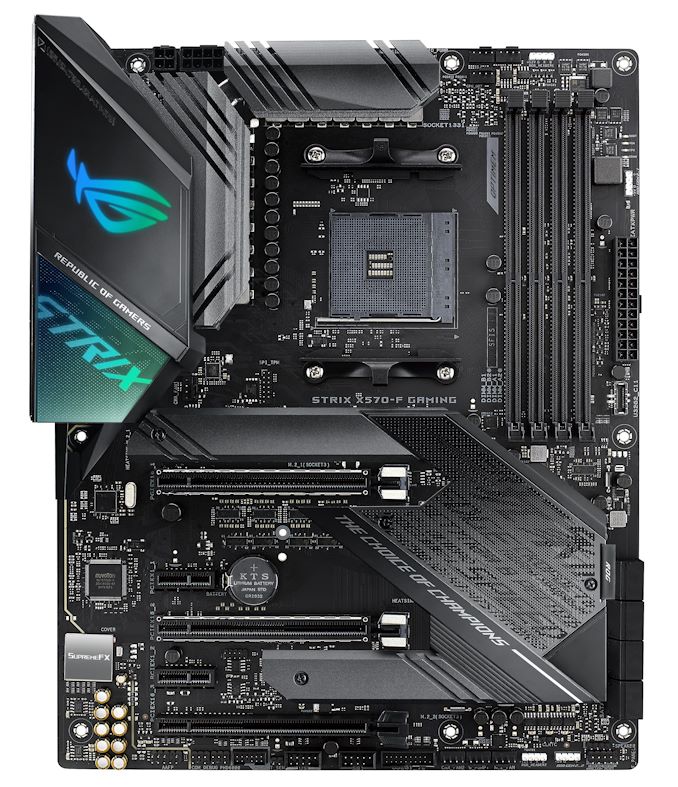The AMD X570 Motherboard Overview: Over 35+ Motherboards Analyzed
by Gavin Bonshor on July 9, 2019 8:00 AM ESTASUS ROG Strix X570-F Gaming
The ASUS ROG Strix X570-F Gaming is the slightly feature slimming ATX sibling of the ROG Strix X570-E Gaming with a very similar aesthetic shared between both models, with fewer premium components and is representative of the mid-range segment of its X570 product stack. The most notable features of the Strix X570-F Gaming include two PCIe 4.0 M.2 slots, eight SATA ports, and an HDMI 2.0b video output on the rear panel. On the design, ASUS has gone with a gaming-inspired which theme of black and grey, with ARGB LEDs implemented into the rear panel cover for a bit of extra flair. The actively cooled X570 chipset heatsink also includes a graffiti-inspired design which fits in with the rest of the board's theme.
On the PCB of the ASUS ROG Strix X570-F Gaming is three full-length PCIe 4.0 ports which are configured to run at x16, x8/x8, and x8/x8/x4. This allows users to run up to two-way NVIDIA SLI and three-way AMD CrossFire multi-graphics card setups. Storage capabilities onboard include two PCIe 4.0 M.2 slots with a pair of M.2 heatsinks which the PCIe 4.0 x4 SSDs are certainly going to appreciate. The board also includes eight SATA ports with support for RAID 0, 1, and 10 arrays. The ASUS ROG Strix X570-F also has four memory slots with the capabilities to run up to 128 GB. Memory support isn't known at present, but more information should be available when this model launches, sometime after 7/7.
The ASUS ROG Strix X570-F uses a single Ethernet port controlled by an Intel I1211-AT Gigabit NIC, while the five 3.5 mm audio jacks and S/PDIF optical output are driven by a SupremeFX S1220 HD audio codec. Looking at rear panel USB, there's three USB 3.1 G2Type-A, one USB 3.1 G2 Type-C, and four USB 3.1 G1 Type-A ports. Also present on the rear panel is a pair of video outputs consisting of a DisplayPort and HDMI 2.0b, with a USB BIOS Flashback button that uses a dedicated USB Type-A port which is clearly highlighted on the IO shield.
Similar to the ASUS ROG X570-E Gaming in terms of stylings, the ROG X570-F Gaming drops some key features to offer users looking for the Strix style, but without the larger hit to the wallet. While a few of ASUS's X570 models are doubled up with Wi-Fi enabled and those without, the Strix-X570-F keeps the core layout, but without the cost-laden features such as Wi-Fi 6, and a 2.5 G NIC. The ASUS ROG Strix X570-F Gaming is almost certainly going to cost less than its better equipped X570-E Gaming sibling, but we currently don't have an MSRP at the time of writing, and this model won't be available at launch.












225 Comments
View All Comments
isthisavailable - Wednesday, July 10, 2019 - link
The industry needs to make up its mind when it comes to USB C. Laptops are launching with only USB C and meanwhile $700 motherboards only have 1 USB C port and 8+ "outdated" USB A'sThe_Assimilator - Wednesday, July 10, 2019 - link
It's almost like there's a huge amount of peripherals with USB-A connectors that people who use PCs expect to continue to work when they upgrade! Isn't backwards compatibility a funny feature?Meanwhile, the only peripherals that laptops generally use are docks, hubs, and storage devices - all of which have USB-C versions out the wazoo.
naris - Wednesday, July 10, 2019 - link
Why are memory speeds and channels show & discussed when talking about chipsets when the memory controllers are in the CPUs? Memory controllers have not been in chipsets for many years now!halfflat - Wednesday, July 10, 2019 - link
ECC support can be hard to verify for mere mortals; collating (or even better, verifiying) ECC capability on these motherboards would be an extremely useful addition to the article.ishkatar - Wednesday, July 10, 2019 - link
Does any of the boards support Raid 5? I only see 0, 1 and 10.Zibi - Wednesday, July 10, 2019 - link
You don't want to use RAID 5 without proper RAID Controller with cache.That means dedicated card.
Actually from performance / security perspective RAID 10 is pretty OK.
The_Assimilator - Wednesday, July 10, 2019 - link
AMD dropped RAID-5 support upon introduction of the AM4 socket (remember, chipset functionality like RAID is now a CPU function). I don't have an issue with that, since -5 is a very uncommon use-case in consumer workloads and if you want to do -5 right, you really want a hardware RAID card with a BBU.But -5 is pretty much dead anyway due to ever-increasing drive sizes - the rebuild time on anything over 1TB is horrendous, what you really want in such a scenario is RAID-6, and no consumer motherboard every has or will support that.
And please don't tell me you're using RAID-5 for data integrity, because invisible corruption is a thing that I have experienced personally. If you want *actual* data integrity, use Windows Storage Spaces or RAID-10, and as a last resort RAID-6.
Arbie - Wednesday, July 10, 2019 - link
There must be something you left out of this roundup. Whatever it was, please go back and put it in, and next time get it right. Thanks.Korguz - Wednesday, July 10, 2019 - link
huh ????Gastec - Wednesday, July 10, 2019 - link
That $700 must be an error right, perhaps of judgement?